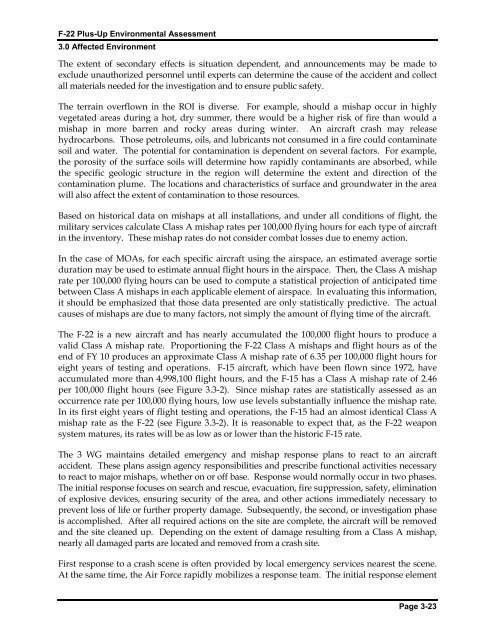F-22 Plus-Up Environmental Assessment - Joint Base Elmendorf ...
F-22 Plus-Up Environmental Assessment - Joint Base Elmendorf ...
F-22 Plus-Up Environmental Assessment - Joint Base Elmendorf ...
You also want an ePaper? Increase the reach of your titles
YUMPU automatically turns print PDFs into web optimized ePapers that Google loves.
F-<strong>22</strong> <strong>Plus</strong>-<strong>Up</strong> <strong>Environmental</strong> <strong>Assessment</strong><br />
3.0 Affected Environment<br />
The extent of secondary effects is situation dependent, and announcements may be made to<br />
exclude unauthorized personnel until experts can determine the cause of the accident and collect<br />
all materials needed for the investigation and to ensure public safety.<br />
The terrain overflown in the ROI is diverse. For example, should a mishap occur in highly<br />
vegetated areas during a hot, dry summer, there would be a higher risk of fire than would a<br />
mishap in more barren and rocky areas during winter. An aircraft crash may release<br />
hydrocarbons. Those petroleums, oils, and lubricants not consumed in a fire could contaminate<br />
soil and water. The potential for contamination is dependent on several factors. For example,<br />
the porosity of the surface soils will determine how rapidly contaminants are absorbed, while<br />
the specific geologic structure in the region will determine the extent and direction of the<br />
contamination plume. The locations and characteristics of surface and groundwater in the area<br />
will also affect the extent of contamination to those resources.<br />
<strong>Base</strong>d on historical data on mishaps at all installations, and under all conditions of flight, the<br />
military services calculate Class A mishap rates per 100,000 flying hours for each type of aircraft<br />
in the inventory. These mishap rates do not consider combat losses due to enemy action.<br />
In the case of MOAs, for each specific aircraft using the airspace, an estimated average sortie<br />
duration may be used to estimate annual flight hours in the airspace. Then, the Class A mishap<br />
rate per 100,000 flying hours can be used to compute a statistical projection of anticipated time<br />
between Class A mishaps in each applicable element of airspace. In evaluating this information,<br />
it should be emphasized that those data presented are only statistically predictive. The actual<br />
causes of mishaps are due to many factors, not simply the amount of flying time of the aircraft.<br />
The F-<strong>22</strong> is a new aircraft and has nearly accumulated the 100,000 flight hours to produce a<br />
valid Class A mishap rate. Proportioning the F-<strong>22</strong> Class A mishaps and flight hours as of the<br />
end of FY 10 produces an approximate Class A mishap rate of 6.35 per 100,000 flight hours for<br />
eight years of testing and operations. F-15 aircraft, which have been flown since 1972, have<br />
accumulated more than 4,998,100 flight hours, and the F-15 has a Class A mishap rate of 2.46<br />
per 100,000 flight hours (see Figure 3.3-2). Since mishap rates are statistically assessed as an<br />
occurrence rate per 100,000 flying hours, low use levels substantially influence the mishap rate.<br />
In its first eight years of flight testing and operations, the F-15 had an almost identical Class A<br />
mishap rate as the F-<strong>22</strong> (see Figure 3.3-2). It is reasonable to expect that, as the F-<strong>22</strong> weapon<br />
system matures, its rates will be as low as or lower than the historic F-15 rate.<br />
The 3 WG maintains detailed emergency and mishap response plans to react to an aircraft<br />
accident. These plans assign agency responsibilities and prescribe functional activities necessary<br />
to react to major mishaps, whether on or off base. Response would normally occur in two phases.<br />
The initial response focuses on search and rescue, evacuation, fire suppression, safety, elimination<br />
of explosive devices, ensuring security of the area, and other actions immediately necessary to<br />
prevent loss of life or further property damage. Subsequently, the second, or investigation phase<br />
is accomplished. After all required actions on the site are complete, the aircraft will be removed<br />
and the site cleaned up. Depending on the extent of damage resulting from a Class A mishap,<br />
nearly all damaged parts are located and removed from a crash site.<br />
First response to a crash scene is often provided by local emergency services nearest the scene.<br />
At the same time, the Air Force rapidly mobilizes a response team. The initial response element<br />
Page 3-23
















